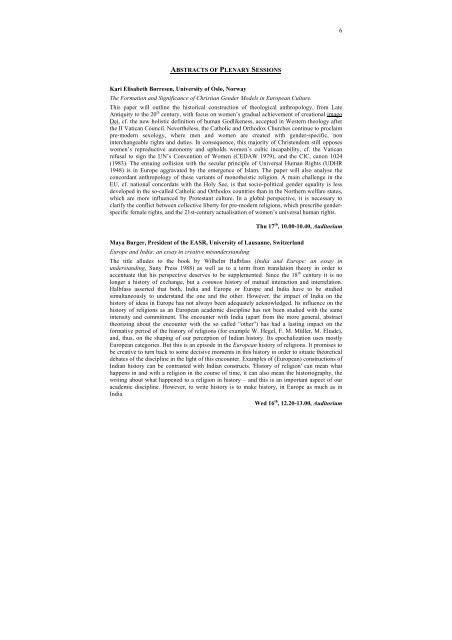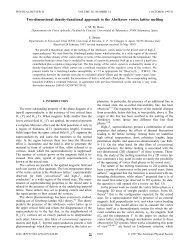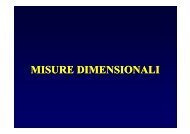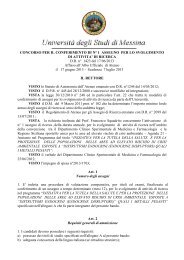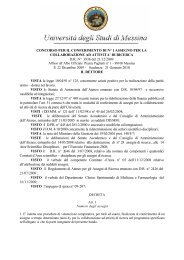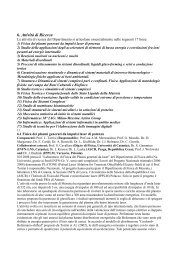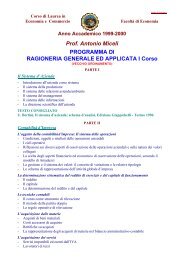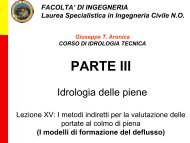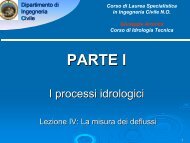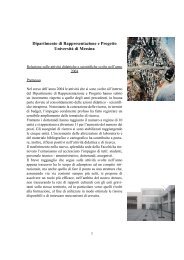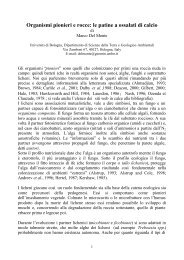PROGRAMME AND ABSTRACTS - Università degli Studi di Messina
PROGRAMME AND ABSTRACTS - Università degli Studi di Messina
PROGRAMME AND ABSTRACTS - Università degli Studi di Messina
Create successful ePaper yourself
Turn your PDF publications into a flip-book with our unique Google optimized e-Paper software.
<strong>ABSTRACTS</strong> OF PLENARY SESSIONS<br />
Kari Elisabeth Børresen, University of Oslo, Norway<br />
The Formation and Significance of Christian Gender Models in European Culture.<br />
This paper will outline the historical construction of theological anthropology, from Late<br />
Antiquity to the 20 th century, with focus on women’s gradual achievement of creational imago<br />
Dei, cf. the new holistic definition of human Godlikeness, accepted in Western theology after<br />
the II Vatican Council. Nevertheless, the Catholic and Orthodox Churches continue to proclaim<br />
pre-modern sexology, where men and women are created with gender-specific, non<br />
interchangeable rights and duties. In consequence, this majority of Christendom still opposes<br />
women’s reproductive autonomy and upholds women’s cultic incapability, cf. the Vatican<br />
refusal to sign the UN’s Convention of Women (CEDAW 1979), and the CIC, canon 1024<br />
(1983). The ensuing collision with the secular principle of Universal Human Rights (UDHR<br />
1948) is in Europe aggravated by the emergence of Islam. The paper will also analyse the<br />
concordant anthropology of these variants of monotheistic religion. A main challenge in the<br />
EU, cf. national concordats with the Holy See, is that socio-political gender equality is less<br />
developed in the so-called Catholic and Orthodox countries than in the Northern welfare states,<br />
which are more influenced by Protestant culture. In a global perspective, it is necessary to<br />
clarify the conflict between collective liberty for pre-modern religions, which prescribe genderspecific<br />
female rights, and the 21st-century actualisation of women’s universal human rights.<br />
6<br />
Thu 17 th , 10.00-10.40, Au<strong>di</strong>torium<br />
Maya Burger, President of the EASR, University of Lausanne, Switzerland<br />
Europe and In<strong>di</strong>a: an essay in creative misunderstan<strong>di</strong>ng<br />
The title alludes to the book by Wilhelm Halbfass (In<strong>di</strong>a and Europe: an essay in<br />
understan<strong>di</strong>ng, Suny Press 1988) as well as to a term from translation theory in order to<br />
accentuate that his perspective deserves to be supplemented. Since the 18 th century it is no<br />
longer a history of exchange, but a common history of mutual interaction and interrelation.<br />
Halbfass asserted that both, In<strong>di</strong>a and Europe or Europe and In<strong>di</strong>a have to be stu<strong>di</strong>ed<br />
simultaneously to understand the one and the other. However, the impact of In<strong>di</strong>a on the<br />
history of ideas in Europe has not always been adequately acknowledged. Its influence on the<br />
history of religions as an European academic <strong>di</strong>scipline has not been stu<strong>di</strong>ed with the same<br />
intensity and commitment. The encounter with In<strong>di</strong>a (apart from the more general, abstract<br />
theorizing about the encounter with the so called “other”) has had a lasting impact on the<br />
formative period of the history of religions (for example W. Hegel, F. M. Müller, M. Eliade),<br />
and, thus, on the shaping of our perception of In<strong>di</strong>an history. Its epochalization uses mostly<br />
European categories. But this is an episode in the European history of religions. It promises to<br />
be creative to turn back to some decisive moments in this history in order to situate theoretical<br />
debates of the <strong>di</strong>scipline in the light of this encounter. Examples of (European) constructions of<br />
In<strong>di</strong>an history can be contrasted with In<strong>di</strong>an constructs. 'History of religion' can mean what<br />
happens in and with a religion in the course of time, it can also mean the historiography, the<br />
writing about what happened to a religion in history – and this is an important aspect of our<br />
academic <strong>di</strong>scipline. However, to write history is to make history, in Europe as much as in<br />
In<strong>di</strong>a.<br />
Wed 16 th , 12.20-13.00, Au<strong>di</strong>torium


